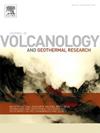加州清湖火山区硫岸汞矿热液系统的气体排放
IF 2.3
3区 地球科学
Q2 GEOSCIENCES, MULTIDISCIPLINARY
Journal of Volcanology and Geothermal Research
Pub Date : 2025-09-21
DOI:10.1016/j.jvolgeores.2025.108453
引用次数: 0
摘要
硫岸汞矿(SBMM)热液系统为clearlake火山场(CLVF)的主动脱气过程提供了见解,clearlake火山场(CLVF)是一个基于全新世火山喷发记录和靠近人口稠密地区的高威胁地区。在这里,我们介绍了2015年至2023年收集的气体样本的化学和同位素分析,以及2023年对SBMM地区进行的第一次全面的二氧化碳通量调查。样品气体富含CO2和ch4(干气≥84 mol%和6 mol%),幔源氦贡献高(3He/4He = 6.54 ~ 7.86 RC/RA)。CO2 (δ13C = - 10.0 ~ - 9.5‰)和CH4 (δ13C = - 35.8‰)的碳同位素组成表明烃源混合,其中富有机质方济各杂岩的变质作用是热液体系的主要来源。气体组成的模拟表明,与空气饱和地下水相互作用的冲刷作用强烈影响观测到的组成变率。根据我们的CO₂通量测量,我们估计SBMM热液区(0.2 km2)的深度衍生CO2排放率为240 t d - 1,与世界上许多静态脱气火山相当。我们还提供了约0.5 t d−1时CH4排放的一阶估计。我们的发现为未来的火山监测工作建立了关键的基线数据,增强了对这一活跃热液系统潜在变化的探测能力。这项工作有助于更广泛地了解火山和变质源对全球碳收支的挥发性贡献,同时突出了基岩地质对CLVF气体组成的强烈影响。本文章由计算机程序翻译,如有差异,请以英文原文为准。
Gas emissions from the Sulphur Bank Mercury Mine hydrothermal system, Clear Lake volcanic field, California
The Sulphur Bank Mercury Mine (SBMM) hydrothermal system offers insights into active degassing processes in the Clear Lake volcanic field (CLVF), a high-threat region based on its record of Holocene eruptions and proximity to populated areas. Here we present chemical and isotopic analyses of gas samples collected between 2015 and 2023, along with the first comprehensive CO2 flux survey of the SBMM area conducted in 2023. Sampled gases are CO2- and CH4-rich (≥84 and 6 mol% in dry gas, respectively) with high mantle-derived helium contributions (3He/4He = 6.54–7.86 RC/RA). Carbon isotopic compositions of CO2 (δ13C = −10.0 to −9.5 ‰) and CH4 (δ13C = −35.8 ‰) indicate mixed sources, with significant contributions from metamorphism of organic-rich Franciscan Complex rocks hosting the hydrothermal system. Modeling of gas compositions shows that scrubbing by interaction with air-saturated groundwater strongly influences observed compositional variability. From our CO₂ flux measurements, we estimate the deeply derived CO2 emission rate from the SBMM hydrothermal area (0.2 km2) at 240 t d−1, comparable to many quiescently degassing volcanoes worldwide. We also provide a first-order estimate of CH4 emissions at approximately 0.5 t d−1. Our findings establish crucial baseline data for future volcanic monitoring efforts, enhancing detection capabilities for potential changes in this active hydrothermal system. This work contributes to the broader understanding of volatile contributions from volcanic and metamorphic sources to the global carbon budget, while highlighting the strong influence of bedrock geology on gas compositions in the CLVF.
求助全文
通过发布文献求助,成功后即可免费获取论文全文。
去求助
来源期刊
CiteScore
5.90
自引率
13.80%
发文量
183
审稿时长
19.7 weeks
期刊介绍:
An international research journal with focus on volcanic and geothermal processes and their impact on the environment and society.
Submission of papers covering the following aspects of volcanology and geothermal research are encouraged:
(1) Geological aspects of volcanic systems: volcano stratigraphy, structure and tectonic influence; eruptive history; evolution of volcanic landforms; eruption style and progress; dispersal patterns of lava and ash; analysis of real-time eruption observations.
(2) Geochemical and petrological aspects of volcanic rocks: magma genesis and evolution; crystallization; volatile compositions, solubility, and degassing; volcanic petrography and textural analysis.
(3) Hydrology, geochemistry and measurement of volcanic and hydrothermal fluids: volcanic gas emissions; fumaroles and springs; crater lakes; hydrothermal mineralization.
(4) Geophysical aspects of volcanic systems: physical properties of volcanic rocks and magmas; heat flow studies; volcano seismology, geodesy and remote sensing.
(5) Computational modeling and experimental simulation of magmatic and hydrothermal processes: eruption dynamics; magma transport and storage; plume dynamics and ash dispersal; lava flow dynamics; hydrothermal fluid flow; thermodynamics of aqueous fluids and melts.
(6) Volcano hazard and risk research: hazard zonation methodology, development of forecasting tools; assessment techniques for vulnerability and impact.

 求助内容:
求助内容: 应助结果提醒方式:
应助结果提醒方式:


